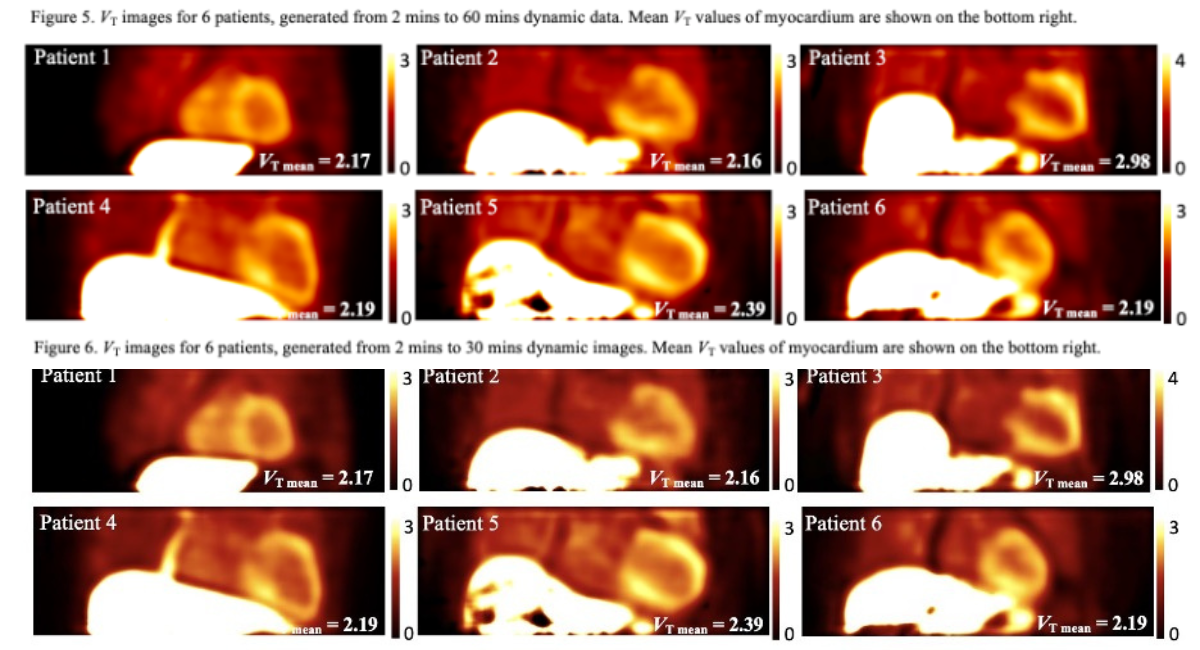Novel Kinetic Model Improves PET Tracer Quantification in ATTR Cardiac Amyloidosis
Kinetic modeling is important to understand how to obtain the best quantitative measurement of novel tracers in the organ of interest.
VT images of six patients generated from 60 minutes (top) and 30 minutes (bottom) of dynamic data using parametric modeling for fully quantitative myocardial volume distribution of 18F-flutemetamol PET imaging tracer.

A new kinetic model for a PET imaging tracer may help significantly improve both the diagnosis of and treatment response for patients with transthyretin (ATTR) cardiac amyloidosis, according to research presented at the 2023 Society of Nuclear Medicine & Molecular Imaging (SNMMI) Annual Meeting, taking place June 24-27, 2023 in Chicago.
Researchers led by Qiong Liu, a PhD student at Yale University, set out to determine a fully quantitative model to better measure myocardial uptake of 18F-flutemetamol, a tracer that has shown promise to detect ATTR cardiac amyloidosis in PET imaging. Current methods that utilize static data analysis are limited due to time constraints related to tracer washout from the myocardium, resulting in a limited or incomplete readout.
Liu and colleagues studied data from six patients with ATTR cardiac amyloidosis who underwent one hour of dynamic PET/CT after receiving 18F-flutemetamol tracer via bolus. They tested various compartmental models against 34 reconstructed dynamic images that included image-derived input functions and myocardium time activity curves. Population-based whole blood-to-plasma ratio correction and plasma metabolite correction were derived from a previous study. They examined both Patlak and Logan plots and tested one-tissue (1T), two-tissue (2T) reversible, and 2T irreversible compartmental models with blood volume estimation. Parametric images of the the equilibrium myocardium to plasma ratio (VT) were then generated.
Liu and colleagues found that the 2T reversible model best quantified the kinetics of the PET tracer, with the VT values generated by the 2T reversible compartmental model consistent with VT values calculated by the Logan plot (P =.99). The mean VT values of the six patients was 2.61 ± 0.47 with plasma metabolite correction and population-based whole blood-to-plasma ratio correction, which was 118% ± 30% higher than those without corrections. The Logan plot best identified the volume of distribution parameter from the first 30-minutes of dynamic scan (mean VT values, 2.35 ± 0.32 (P =.01), 10.1% ± 5.5% lower than 60-minute data) as a quantitative parameter that could potentially improve diagnosis and evaluation of treatment effect in this patient population.
“These findings suggest that commonly employed semiquantitative methodologies, such as standardized uptake values used for 18F-FDG, are notoptimal for 18F-flutemetamol," Liu said in a statement. "Using parametric modeling to fully quantify volume of distribution may provide clinicians with a more accurate and robust method for assessing the presence and progression of amyloid plaques in the myocardium, ultimately improving patient care."
Click here for more coverage of SNMMI 2023.
Reference
Liu Q, Shi T, Gravel P, et al. Dynamic Imaging and Tracer Kinetic Modeling of 18F-flutemetamol PET for ATTR Cardiac Amyloidosis Patients. Presented at: SNMMI 2023. June 24-27, 2023; Chicago, Ill. Abstract 270.
Emerging AI Algorithm Shows Promise for Abbreviated Breast MRI in Multicenter Study
April 25th 2025An artificial intelligence algorithm for dynamic contrast-enhanced breast MRI offered a 93.9 percent AUC for breast cancer detection, and a 92.3 percent sensitivity in BI-RADS 3 cases, according to new research presented at the Society for Breast Imaging (SBI) conference.
The Reading Room Podcast: Current Perspectives on the Updated Appropriate Use Criteria for Brain PET
March 18th 2025In a new podcast, Satoshi Minoshima, M.D., Ph.D., and James Williams, Ph.D., share their insights on the recently updated appropriate use criteria for amyloid PET and tau PET in patients with mild cognitive impairment.
Can Abbreviated Breast MRI Have an Impact in Assessing Post-Neoadjuvant Chemotherapy Response?
April 24th 2025New research presented at the Society for Breast Imaging (SBI) conference suggests that abbreviated MRI is comparable to full MRI in assessing pathologic complete response to neoadjuvant chemotherapy for breast cancer.
What New Research Reveals About Novice Use of AI-Guided Cardiac Ultrasound
April 4th 2025In a study recently presented at the American College of Cardiology (ACC) conference, researchers found that novice use of AI-guided cardiac ultrasound after an AI-enabled electrocardiogram increased the positive predictive value for reduced left ventricular ejection fraction (LVEF) or aortic valve stenosis by 33 percent.
GE HealthCare Debuts AI-Powered Cardiac CT Device at ACC Conference
April 1st 2025Featuring enhanced low-dose image quality with motion-free images, the Revolution Vibe CT system reportedly facilitates improved diagnostic clarity for patients with conditions ranging from in-stent restenosis to atrial fibrillation.